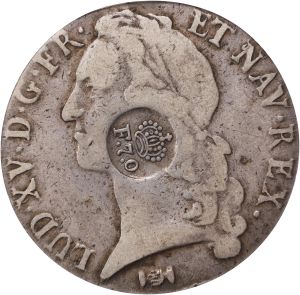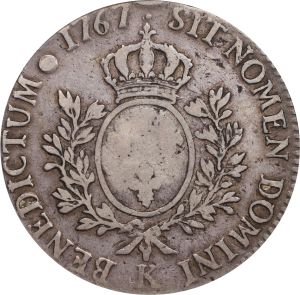Difference between revisions of "Philippines (1832-34) c/s 8 reales KM-A58"
(Created page with "300px|thumb|Stack's Bowers September 2025 ANA sale, lot 42499 300px|thumb This specimen was lot 42499 in Stack's Bowers...") |
m (Text replacement - "Stack's Bowers September 2025" to "Stack's Bowers 2025") |
||
| Line 1: | Line 1: | ||
| − | [[Image:SB825-42499o.jpg|300px|thumb|Stack's Bowers | + | [[Image:SB825-42499o.jpg|300px|thumb|Stack's Bowers 2025 ANA sale, lot 42499]] |
[[Image:SB825-42499r.jpg|300px|thumb]] | [[Image:SB825-42499r.jpg|300px|thumb]] | ||
Latest revision as of 14:53, 8 October 2025
This specimen was lot 42499 in Stack's Bowers ANA sale (Oklahoma City, OK, August 2025), where it sold for $84,000. The catalog description[1] noted,
"Extremely Rare and Possibly Unique Early French Host. PHILIPPINES. Philippines - France. 8 Reales, ND (ca. 1833-34). Manila Mint. Ferdinand VII. PCGS FINE-15; Countermark: EF Details. Issued by decree of 2 October 1832, commencing 5 October 1832 until 20 December 1834. Countermark: Type V, crowned F.7.o within circular indent. Countermark applied to the obverse of a 1767-K, Bordeaux Mint, France Ecu of Louis XV (KM-512.11; Gad-322). This extreme rarity far outpaces most other coins from this series and is by far one of the more interesting hosts this cataloger has researched. For all countermark varieties, either F.7.o or Y.II., we have only seven other examples documented for this host country! Of those seven pieces, six are of Isabel II and of the later 5 Francs denomination, two of which are of a spurious nature. While we have only one other documented example bearing an F.7.0 countermark, a later 1784-K Ecu of Louis XVI, which unfortunately has been holed and crudely plugged, but happens to feature the same stamp as the present piece. The countermark is deeply impressed and bold with clear diagnostics on a wholesome looking and evenly worn host. The surfaces are relatively smooth with minor marks and abrasions that one would associate with the designated grade. A pleasing flint gray graces the fields with richer coloration amongst the devices and light gray tone on the high points, all complimented by a slight iridescent sheen that becomes apparent when tilted in the light. Wholly original looking with a pleasing appearance and good eye appeal, this highly sought after host ranks amongst the rarest from the entire series and is probably a UNIQUE combination. Destined for an advanced collection of the highest caliber, the opportunity to obtain such a special piece from this series does not present itself often. Serious consideration should be taken by the connoisseur of Filipino numismatics looking to acquire strange and unusual pieces to add depth to their collection.
Besides Spanish Colonial Pillar coinage, the present piece is the earliest dated host coin for this country or otherwise that we have recorded for this series. Not only is it an early dated host, but was struck on a heavier weight standard of 29.45 g of 0.917 Fine silver, nearly 2.5 g more than other trade silver of the time that were based on the Latin standard of 27 g of around 0.900 Fine silver, but was on par with the earlier Pillar issues in terms of purity. Containing nearly three Cuartillas (1/4 Real) of additional silver compared to the more prominent Latin standard counterparts. Though this would have circulated freely once the countermark was applied, in essence its value was lowered to that of an 8 Reales. It is our understanding that the combination of an Ecu with either an F.7.0 or Y.II. countermark is missing from every major collection, both public or private, including the Legarda, Cacho, de I. Jesus, Pineda, Czahor, Gibbs, American Numismatic Society (ANS), American Numismatic Association (ANA), British Museum (BM), Casa de Moneda (Madrid) and the Bangko Sentral Ng Pilipinas (BSP) to name a few. It is also worth mentioning that we were unable to locate any other example of this type in auction appearance previously. In fact, this will be the first public appearance that we are aware of. Truly a magnificent piece rivaled by few others from this series."
This counterstamp was applied 1832-34 to Latin American pesos arriving in Manila from the newly independent republics, none of which were recognized by Spain. The SCWC lists over forty different types receiving this counterstamp. French royal coins were not supposed to be counterstamped, already being legal for trade, so those that did are rare. In addition, the French écu was worth more than a peso.
Recorded mintage: unknown.
Specifications: host coin 29.48 g, 0.917 fine silver, 41 mm diameter.
Catalog reference: cf. KM-A58 (for host country); Basso-55; PNM#6-Unlisted; PNM#16-Unlisted; PNM#21-Unlisted; Cacho-Unlisted; Gil-5-4-1-C.
- Basso, Aldo P., Coins, Medals and Tokens of the Philippines, Menlo Park, CA: 1968.
- Ganzon de Legarda, Angelita, Piloncitos to Pesos, A Brief History of Coinage in the Philippines, Manila: Bancom Development Corporation, 1976.
- Michael, Thomas, and Tracy L. Schmidt, Standard Catalog of World Coins, 1801-1900, 9th ed., Iola, WI: Krause Publications, 2019.
- Cayón, Adolfo, Clemente Cayón and Juan Cayón, Las Monedas Españolas, del Tremis al Euro: del 411 a Nuestros Dias, 2 volumes, Madrid: Cayón-Jano S.L., 2005.
- Calicó, Xavier, Numismática Española: Catálogo General con Precios de Todas las Monedas Españolas Acuñadas desde Los Reyes Católicos Hasta Juan Carlos I, 1474 a 2001, Barcelona: Aureo & Calicó, 2008.
- [1]Orsini, Matt, Kyle Ponterio and Jeremy Bostwick, August 2025 Global Showcase Auction, World & Ancient Coins, featuring The Richard August Collection and the Richard Margolis Collection, Costa Mesa, CA: Stack's Bowers Galleries, Inc., 2025.
Link to:
- France 1767-L ecu
- (1832-34) "F-7o" c/s on Peru 2 reales
- (1832-34) "F-7o" c/s on Argentina 8 soles
- (1832-34) "F-7o" c/s on Bolivia republic 8 soles
- (1832-34) "F-7o" c/s on Brazil colonial 960 réis
- (1832-34) "F-7o" c/s on Brazil united kingdom 960 réis
- (1832-34) "F-7o" c/s on Central American Rep. 8 reales
- (1832-34) "F-7o" c/s on Chile volcano peso
- (1832-34) "F-7o" c/s on Mexico pillar 8 reales
- (1832-34) "F-7o" c/s on Mexico Charles IV 8 reales
- (1832-34) "F-7o" c/s on Mexico (imaginary bust) 8 reales
- (1832-34) "F-7o" c/s on Mexico (Iturbide) 8 reales
- (1832-34) "F-7o" c/s on Iturbide 8 reales
- (1832-34) "F-7o" c/s on Mexico "hook-neck" 8 reales
- (1832-34) "F-7o" c/s on Mexico republic 8 reales
- (1832-34) "F-7o" c/s on Peru Libre 8 reales
- (1832-34) "F-7o" c/s on Peru 8 reales, early type
- (1832-34) "F-7o" c/s on Peru republic 8 reales
- (1832-34) "F-7o" c/s on Peru (Cuzco) 8 reales, late type
- (1832-34) "F-7o" c/s on Peru (Cuzco) 8 reales, early type
- Coins and currency dated 1832

